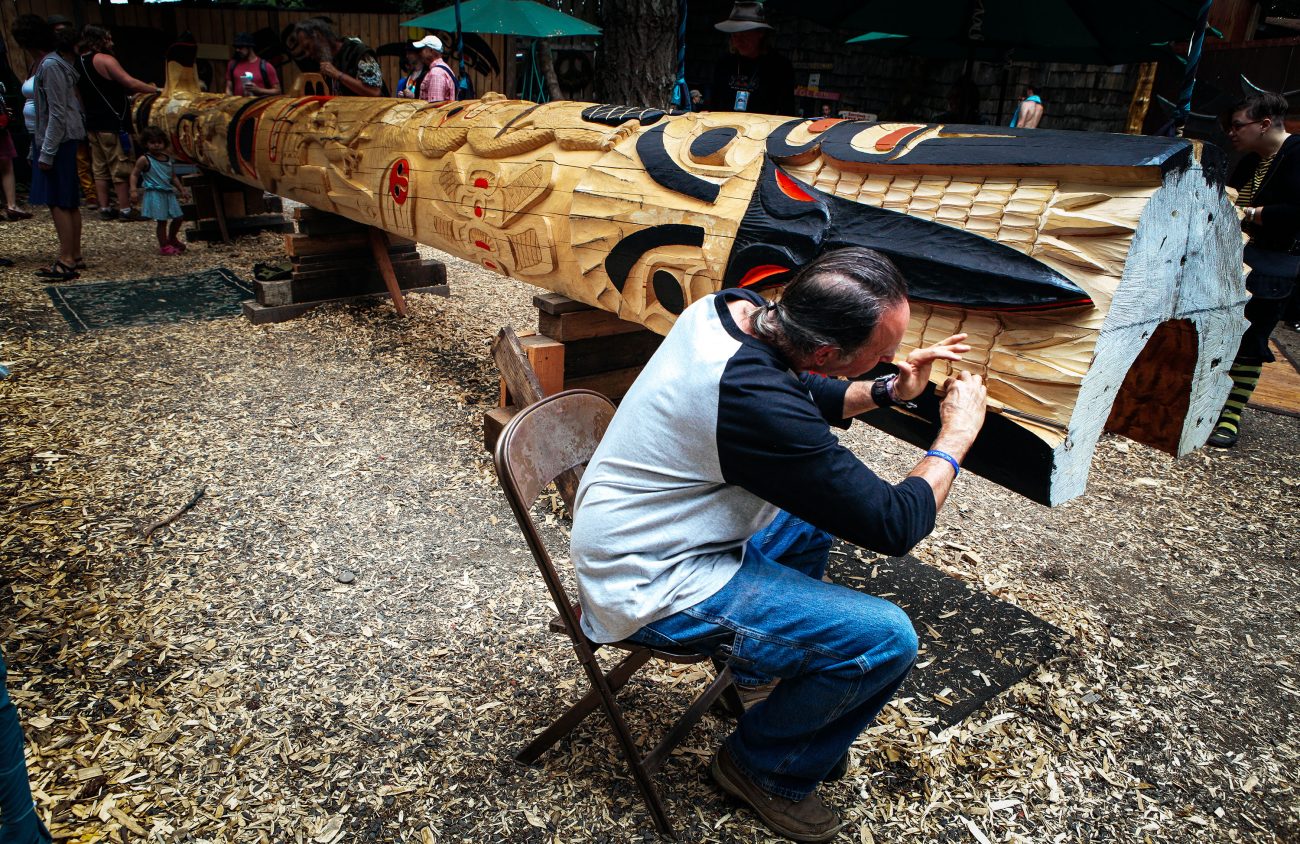A slow-motion collision between art and cultural politics led the Oregon Country Fair this week to cancel the planned installation of a 36-foot-tall Native-inspired carved story pole at its 280-acre site in Veneta.
For at least the past five years, the Fair has been planning to erect the pole, which was created by Ritz Sauna and Showers, an independently incorporated business that has been part of the four-decade-old summer festival from its beginning years.
But Native Americans, particularly from the local Kalapuya tribe, increasingly objected to the pole as “cultural appropriation.” At a sometimes-acrimonious OCF board meeting the night of May 1, Natives compared the pole to “cultural genocide.”
The board voted unanimously to cancel the project, leaving lead artist Brad Bolton and Ritz Sauna leaders unclear on what to do next with the pole, which is nearly complete and was to be installed in July.
The story pole got its start years ago when Ritz Sauna’s director George Braddock began talking with Bolton about a way to tell the history of the sauna through art. In 2012, after two members of the Flamingo Clan, as the Ritz Sauna members style themselves, along with two other Fair staffers were killed in an airplane crash, Braddock decided the pole should also memorialize the dead, Bolton said.
The Fair board approved placing the pole at the Fair’s site at a meeting in April 2016, with the condition that it be accompanied by an informational display “concerning the ‘Story Pole’ as Culturally Inspired Art or Cultural Appropriation,” Fair board minutes show.
But on Tuesday the Fair distanced itself from the project. “It doesn’t belong to the Fair,” site and facilities manager Shane Harvey said when asked about the future of the pole. “It belongs to the Ritz Sauna.”
Bolton declined to talk about the story pole after the Fair board meeting, referring questions to a Ritz Sauna spokeswoman. But before Monday’s meeting he explained that he has been making Native-style art for more than two decades without any objection from tribes. Bolton’s work draws heavily on iconic Northwest Coast formline art, a style using stark ovoid and U shapes to depict narratives and ideas. Many of his smaller formline works already adorn the Ritz Sauna.
“I started trying to learn Native style 20-some years ago,” Bolton said. “I liked formline style. It’s a natural way to draw.”
In a statement issued Wednesday morning, Ritz Sauna expressed regret at any “distress” the situation has caused, but noted that the story pole has been repeatedly approved by the Fair over the past five years.
“We were assured that the Oregon Country Fair continued to support the installation of the Ritz Story Pole,” it said. “But, without our input or inclusion on the public agenda and in violation of agreements and processes that we had engaged in good faith, the Oregon Country Fair Board determined by a unanimous vote on May 1 that our art piece could not be raised as planned or displayed on OCF property. Ritz staff learned that the board planned to take this action only six hours before the meeting.”
The issue of cultural appropriation is hardly new to the Fair, which did try to talk to Native tribes about the pole. But minutes from the April 2016 meeting at which the pole’s installation was formally approved suggest those efforts may have been limited and formal.
Board member Indigo Ronlov is quoted saying, “We asked for the conversation with the tribes, and that deadline has passed. In my mind as a board member, the tribes did not respond in an organizationally valid way.”
Sculptor Kate Ali, a longtime Fair-goer who teaches art at Lane Community College, called the story pole saga a lost opportunity for cultural conversation.
“Art is a form of communication,” she said. “I think the fact that the artist wasn’t aware of the risks of cultural appropriation is unfortunate, to say the least. Like it or not, this story pole scenario has stepped on a nerve that has roots in cultural tensions felt in our community, country and world at large. It shows that this is an area that needs to be discussed at length.”
Ali has considerable experience in public art as both an artist and as a project manager. She says she would prefer the pole be erected as planned.
“I support raising the pole, but bring in a Native carver to discuss traditional methods,” Ali suggested. “Post signage that gives the history of the story pole told by multiple tribes across the Northwest. Put up a board where people can express their own reactions. Tell the story of this pole from both sides. Respect people’s differences, while allowing a healthy dialogue to take place. That’s what the Fair is all about.”
Esther Stutzman, a Kalapuya and Coos storyteller in Yoncalla, said the Fair’s efforts to consult with Natives about the pole were inadequate — and ignored the fact that the Fair sits in historical Kalapuya territory, so its formline design is inappropriate.
“The lack of consultation, that’s what burns me. There are plenty of Kalapuya people around. It’s the same thing that’s happened over and over again. We’re still waiting for someone to reach out. Kalapuya people are easy to find. They can’t give the excuse that there was no one to talk to,” Stutzman said.
“And as a Kalapuya I am extremely insulted that this is a Northwest coast totem pole when that sort of thing didn’t exist here. That is a stereotype.”
